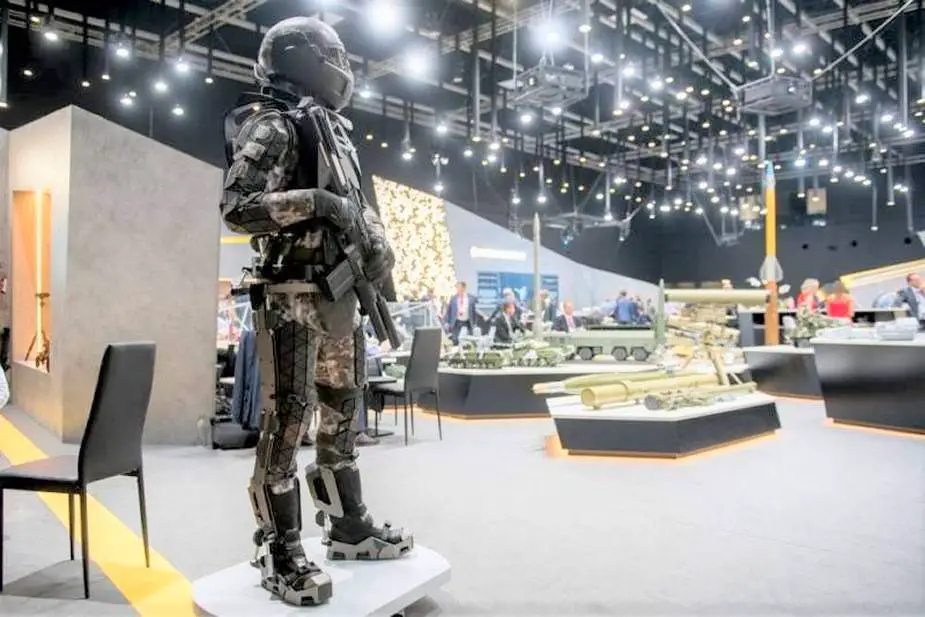Rostec Corporation launched the design of a fourth-generation combat outfit in early 2021 on Defense Ministry orders. It is to replace the third-generation Sotnik outfit. Some of the elements are undergoing preliminary trials, the Independent Military Review writes.
Follow Army Recognition on Google News at this link

Concept of BEV "Ratnik-3" (Picture source: Rostec)
TsNIItochmash, Kalashnikov and other companies participate in the R&D. The designers analyze the best combat outfits in the world and engage in technological research. A complex interdepartmental development program up to 2035 to develop the combat outfit will be adopted.
The fourth-generation outfit has to include the latest achievements of the military-industrial system, such as protection and life support, robotized equipment, integrated information exchange systems. The innovative solutions include mine-resistant boots, a suit that hides a soldier, an antiradar element. The soldier connects with an automatic control system and small drones that transmit images in real-time to the helmet screen or protective goggles.
The fourth-generation outfit borrows the advantages of previous models. TsNIItochmash supplied over 300,000 Ratnik outfits in eight years. It adapts to the physical buildup of a soldier. Besides the basic option, there are outfits for commanders, snipers, machinegun operators, combat vehicle crews.
Ratnik provides for numerous missions in the battlefield. It unites over 60 elements: guns, sights, individual protection, autonomous heat sources, communications and active hearing protection. TsNIItochmash designed Ratnik in late 2000s. Trials confirmed the correctness of technical solutions.
Ratnik has several types of protection. The combat protective suit 6B49 is an overall or a set of jacket and trousers made of flexible fabric protection. It is resistant to fragmentation and pistol bullets. There are also the 6B47 helmet and modern 6B45 armored vest. Fabric armor provides first-class protection. Ceramic-composite Granit-5 provides 5A-class protection. The armored vest has a total space of 45 square decimeters and 25 of them are armored elements. The product with ceramic protection weighs 8.7 kg.
There is the 6B45-1 assault option of the armored vest. It includes shoulder protection and a bullet-resistant apron, additional shock absorbers and reinforced ceramic panels that correspond to the sixth class. The vest has a 6B45-2 floating set.
Existing armored vests are upgraded. New ones are designed with prospective materials of lower weight and increased strength. Approaches to architecture are changing. A protective overall may appear with armored elements on a maximum space.
otnik outfit with an exoskeleton allows carrying 50 and more kg of cargo. The fourth-generation outfit demands to upgrade the exoskeleton, add power sources, and increase survivability. Foreign experts fear that additional protection will excessively increase the weight of the armor. Rostec CEO Sergey Chemezov said an active exoskeleton allows carrying up to 60 kg of cargo. “Walking and running energy losses decrease 15 percent. The load on the locomotor system falls by 50 percent. Fire precision from small arms increases by 20 percent,” he said.
TsNIItochmash said batch production of active exoskeletons can begin in Russia in four-six years. An active exoskeleton is designed for the new-generation outfit. Its autonomous operation will be increased to 24 hours. The soldier can move at a speed of 20 km/h and carry 100 kg of cargo.
It is possible to produce polymeric armor of polyethylene. When a heated bullet hits the armor, it melts the polyethylene. The polymer sticks to the bullet and slows it down. It will stop completely if there is sufficient plastic on its way. The Russian polyethylene armor is called Supernit (Super Thread). Experts say the material is lighter than the Israeli and US body armor but provides better protection. Polyethylene armor can stop a 12.7mm bullet. However, it is unclear whether it is light enough for a soldier to carry it.
Besides robots and exoskeletons, the Russian outfit of the soldier of the future integrates micro drones. They are much smaller than reconnaissance and combat drones. They have the size of the flat of a hand and can be launched from a shoulder. They are electrically powered and can fly for an hour or two.
It is impossible to detect micro drones. Their stabilized optical-electronic station transmits images also in a strong wind. The drone can land on the ground and water. It can be controlled manually or preset for autonomous operation with GPS coordinates.
Miniature drones have to covertly control residential settlements for a short time. A soldier does not have to enter the settlement with minimal information about the terrain and buildings. He can deploy the drone at a safe distance to see the buildings and obstacles. The soldier can control the flight without exposing himself and collect important video information in real-time.
Drones are an inalienable instrument in the battlefield and various secret operations. They are of major importance for solo soldiers and groups. However, there are problems with their introduction in Russia and foreign armies.
It is necessary to decrease the weight and size of onboard equipment to integrate more sensors into one drone and make it carry the equipment designed for a bigger craft. More powerful electric batteries are also necessary.
Prospective micro-drones can be included in the outfit of artillery pointers, army scouts, officials of combined arms units. Experts believe drones of the new outfit will be of the size of a grenade for the under-barrel launcher.
© Copyright 2021 TASS / Army Recognition Group SPRL. All rights reserved. This material may not be published, broadcast, rewritten or redistributed.














